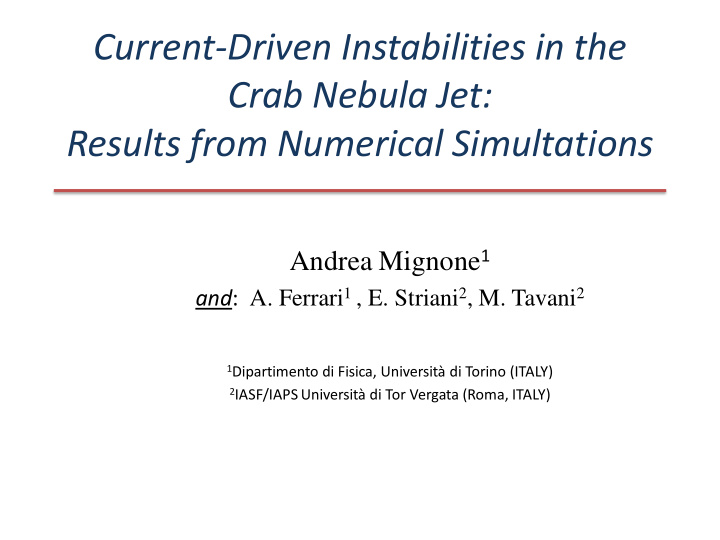



Current-Driven Instabilities in the Crab Nebula Jet: Results from Numerical Simultations Andrea Mignone 1 and : A. Ferrari 1 , E. Striani 2 , M. Tavani 2 1 Dipartimento di Fisica, Università di Torino (ITALY) 2 IASF/IAPS Università di Tor Vergata (Roma, ITALY)
1. Observational Evidence 2. Numerical Models of Relativistic MHD Jets 2D Axisymmetric models 3D models Kink instabilities 3. Results 4. Summary
NW jet X-ray observations (Chandra) show the emergence of bipolar jets extending to the SE and NW of the pulsar; SE jet A region of diffuse emission (Anvil) may be associated with shocks and marks the base of the X-ray and optical jet; Knots of emission are seen along the jets; In the SE jet material flows with v/c 0.4 slowing down to 0.02 into the nebula;
SE jet morphology is “S” shaped and show remarkable time variability: 2001 2010 evidence for some kind of flow instability (Current Driven ?)
Jet forms downstream of the wind termination shock; Magnetic fields confine matter towards polar axis; “ tooth-paste ” effect: hoop stress of the azimuthal Credit: S. Komissarov magnetic field carried by the wind (Lyubarsky 2002). Models confirmed by 2D axisymmetric numerical simulations (Komissarov & Lyubarski 2003,2004, Del Zanna et al. 2004, Bogovalov et al. 2005)
For moderate/large = B 2 /(4 c 2 2 ) magnetic hoop stress suppresses high velocity outflows in the equatorial plane and divert them towards the polar axis partially driving the super-fast jet 1 1 Del Zanna et al, A&A (2004) 421,1063
Results from 2D axisymmetric simulations predict hollow and hot jets initially carrying purely axial current (B 0, B z = B R = 0); Bz = 0 Pitch = 0; 1.3 Ms 2 (hot jet); j / e 10 -6 Two free parameters: 0.1 10 and 2 4 ;
We consider a 2-parameter ( , ) family of light, hot jets with j / e =10 -6 ; M s = 1.7; 2 ). with (B m Radial momentum balance holds across the beam
We solve the equations of a relativistic perfectly conducting fluid describing energy/momentum and particle conservation (relativistic MHD equations) We use the PLUTO 1,2 code for astrophysical fluid dynamics ( http://plutocode.ph.unito.it ); Linear reconstruction + HLLD Riemann solver; Numerical resolution 320 x 320 x 768 zones ( 20 zones on the jet). 1 Mignone et al, ApJS (2007) 170, 228; 2 Mignone et al, ApJS (2012) 198, 7
These jet configurations are unstable to a variety of modes, mainly KH and CD; For non-zero velocities KH and CD modes mix up 1 . At large magnetizations, the m=1 CD mode (kink) prevails. At large velocities KH modes prevails. = 1; = 2 1 Bodo et al. MNRAS (2013, accepted)
We consider a 3D Cartesian domain with x,y [-0.8, 0.8] (ly), z [0, 2.5] (ly). ISM SNR Remnant Freely expanding supernova ejecta (3 M sun , E = 10 51 erg) for 0.2 < r < 1 (ly) Pulsar wind structure not considered: jet already formed as the result of the collimation process; Supersonic injection nozzle at the lower Jet z-boundary.
and are free parameters. We consider slow and and fast jets with weak, moderate and strong magnetic fields (6 cases) = 2 = 4 = 0.1 A1 B1 = 1 A2 B2 = 10 A3 B3
= 2 = 4 = 0.1 A1 B1 = 1 A2 B2 p = 10 A3 B3
Low speed jets advance slowly (v head < 0.02) large density contrast; Evolve entirely inside the remnant; Larger drive magnetically supported jets and show the largest deflections;
High-speed jets propagete faster (v head < 0.05); Reach the outer supernova remnant after 50 years; For large deflections are present but smaller than low speed jets Lorentz factor has a stabilizing effect.
Jets with =4 “ drill out” of the remnant in less than 50 years…
Back-end regions: quasi-periodic stationary pinch (m=0) shocks; Front-end regions: jet fragmentation at deflection sites forming short-lived unstable structures; Kinked deflections p Pinching shocks
Front-end regions: rapid variability strong interaction with the ambient For strong magnetization formation of twisted helical structures. J= B
Center of mass amount of deflection; Low-speed ( 2), magnetized ( 1) jets show the largest bending ( 20 R j ); Larger Lorentz factors ( 4) have a stabilizing effect 1 ; Weakly magnetized jets less affected by the growth of instability; 1 Bodo et al. MNRAS (2013, accepted)
Change in trajectory variation of the average propagation velocity. Low-speed jets large-scale curved structure with gradually changing from 0 ◦ (base) to 90 ◦ (head); High-speed jets stabilized by the larger inertia, build large kicks at the head.
Magnetic field remains mainly toroidal or helical during the propagation; Azimuthal field “ shields ” the core preventing interaction with the surrounding 1 . Poynting flux efficiently diverted at the termination shock and scattered via the backflow to feed the cocoon. Magnetic field dissipates and becomes turbulent in the cocoon ( randomization 2 ) 1 Mignone et al, MNRAS (2010) 402, 7; 2 Porth et al., MNRAS (2013)
Current sheets localized in two regions: • at conical pinch shocks quasi-steady, periodic • at jet “ kinks ” short-lived episodes Magnetic reconnection particle acceleration regions ?
3D models of azimuthally confined relativistic jets are very different from 2D axisymmetric models: Kink-unstable non-axisymmetric structures with large time-variability; Large ( 1) leads to considerable jet deflections, one-sided propagation; Jet wiggling progressively more pronounced towards the jet head Larger Lorentz factors stabilizing effect; Multiple shocks observed at pinching regions and deflection sites where flow changes direction; Low-speed ( 2), moderately/highly magnetized jets ( 1-10) are promising candidates for explaining the morphology of the Crab jet. Future models will consider the jet-torus connection in 3D
Thank you
Recommend
More recommend